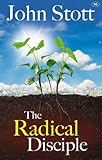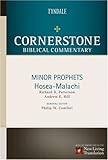
 There is a certain poignancy to this book – it is John Stott’s "farewell" – his final publication. Over the years he has produced dozens of books covering Biblical exposition right through to engagement with all kinds of contemporary issues. His book "The Cross of Christ" is certainly a contender for the best Christian book I have ever read, and his contributions to the Bible Speaks Today series are amongst the best on offer (Sermon on the Mount, Romans, Acts, Galatians, Ephesians, 1 & 2 Thessalonians, 1 Timothy & Titus, 2 Timothy). He is one of the most (if not the most) widely respected evangelical leaders in the UK, and deservedly so. So when he writes a "farewell" book, it’s definitely going to be worth paying attention to.
There is a certain poignancy to this book – it is John Stott’s "farewell" – his final publication. Over the years he has produced dozens of books covering Biblical exposition right through to engagement with all kinds of contemporary issues. His book "The Cross of Christ" is certainly a contender for the best Christian book I have ever read, and his contributions to the Bible Speaks Today series are amongst the best on offer (Sermon on the Mount, Romans, Acts, Galatians, Ephesians, 1 & 2 Thessalonians, 1 Timothy & Titus, 2 Timothy). He is one of the most (if not the most) widely respected evangelical leaders in the UK, and deservedly so. So when he writes a "farewell" book, it’s definitely going to be worth paying attention to.
The book is a call for us all to be "radical disciples". To be radical is to be deep-rooted and whole-hearted. Stott picks out eight areas to explore in which we can become more committed followers of Jesus.
Our common way of avoiding radical discipleship is to be selective; choosing those areas in which commitment suits us and staying away from those areas in which it will be costly. But because Jesus is Lord, we have no right to pick and choose the areas in which we will submit to his authority.
The first area is non-conformity. Both escapism and conformism are forbidden to the believer. We are called to engage with our culture without compromise. Stott identifies four areas in which we need to refuse to conform: pluralism, ethical relativism, materialism, and narcissism (love of self).
The second area is closely related – Christlikeness is the will of God for the people of God. Stott takes us on a Bible-study showing the call to Christlikeness, some specific ways in which we are to be like Christ, and some implications of our Christlikeness. One of the reasons our evangelistic efforts fail is that we don’t look like Christ.
God’s purpose is to make us like Christ, and God’s way is to fill us with his Holy Spirit
The third area is maturity. Stott laments the fact that the modern church can be summed up in the phrase "growth without depth". He draws on Col 1:28-29 to bring out some aspects of maturity. In particular, we need a fresh vision of Christ, from the pages of Scripture. We must look for Christ as we read the Scriptures, in order to love, trust and obey him.
"Ignorance of Scripture is ignorance of Christ."
A fourth area is creation care. The simple fact that this chapter is here shows Stott’s commitment to applying Scripture to contemporary issues. He starts by building a biblical case for our responsible stewardship of the earth, avoiding the two extremes of deification of nature and exploitation of nature. He commends the work of tearfund and A Rocha, and calls us to be deeply committed to care for the creation. He quotes Chris Wright:
It seems quite inexplicable to me that there are some Christians who claim to love and worship God, to be disciples of Jesus, and yet have no concern for the earth that bears his stamp of ownership. They do not care about the abuse of the earth and indeed, by their wasteful and over-consumptive lifestyles, they collude in it.
A fifth area is simplicity. John Stott speaks from a position of integrity on this subject, since his book sales and speaking engagements could have made him a millionaire, yet he practices what he preaches, giving all his book royalties towards the work of providing books for believers and pastors in poorer countries. He feels grieved that the International Consultation on Simple Lifestyle which took place in March 1980 received very little attention, and this chapter is simply given to republish their statement (which he co-wrote with Ron Sider). This is a very challenging chapter, and one that exposes deep-seated idols that we are reluctant to part with. It is sad that Stott seems to be something of a lone voice in the evangelical world on this subject.
The sixth area is balance. In this chapter Stott expounds 1 Peter 2:1-17 and brings out three areas to hold in balance:
- Both individual discipleship and corporate fellowship
- Both worship and work
- Both pilgrimage and citizenship
The seventh area is dependence. He movingly speaks of his experiences of growing increasingly frail and weak. Humiliation is the road to humility. He notes that we start and end our lives completely dependent on others. We are not designed to be independent from one another: "You are designed to be a burden to me and I am designed to be a burden to you."
Christ himself takes on the dignity of dependence. He is born a baby, totally dependent on the care of his mother. He needs to be fed, he needs his bottom to be wiped, he needs to be propped up when he rolls over. And yet he never loses his divine dignity. And at the end, on the cross, he again becomes totally dependent, limbs pierced and stretched, unable to move. So in the person of Christ we learn that dependence does not, cannot, deprive a person of their dignity, of their supreme worth. And if dependence was appropriate for the God of the universe, it is certainly appropriate for us.
The final chapter deals with death. In it he explores from several angles the paradox of Christianity that death is the road to life. Our disicipleship involves a death to self. Our mission leads to the cross. He speaks of persecution and martyrdom, before moving finally to consider our mortality, and how death has been robbed of its horrors for the Christian.
Basic to all discipleship is our resolve not only to address Jesus with polite titles, but to follow his teaching and obey his commands.
In conclusion, this is a book you will want to read if you have had any contact with John Stott’s teaching ministry before. Though he is far too humble to say it about himself, it comes from a man who has fought the good fight, finished the race, and kept the faith (2 Tim 4:7). He has not asked us to do anything that he has not modelled first in his own life. It is a fitting farewell from a remarkable servant of God and I pray that his vision of radical discipleship will be fully embraced by the next generation.

It’s time for another in my series of commentary reviews from Volume 10 of the Cornerstone Biblical Commentary series, this time Hosea.











